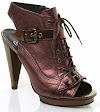In the 1920's, 30's and 40's, Big name Band Leaders, played their music from Ballrooms, broadcasting live, over the radio..... but by the 1950's and 60's, Teenagers were dancing to their favorite music on American Bandstand.....
The shows popularity helped Dick Clark become an American media mogul and inspired similar long-running music programs, such as Soul Train and Top of the Pops. Clark eventually assumed ownership of the program through his Dick Clark Productions company.
While Black artists were permitted to perform, only white dancers were allowed. They feared the backlash that might happen if Black boys danced close to white girls. Black teenagers were banned. There was a protest in the early 60's, Eventually Black teens were allowed.
In 1959, Maybelline featured an African American model in their ad's. The Maybelline Company sold to Plough Inc. in December of 1967.
Read more about the 1950 and 60's and how Maybelline influenced American culture, in my book, The Maybelline Story and the Spirited Family Dynasty Behind It.
American Bandstand was a major success, running daily Monday through Friday until 1963, then weekly on Saturdays until 1987.
In 1964, the show moved from Philadelphia to Hollywood, California. Dick Clark interviews,
Dick Clark became the full-time host on July 9, 1956.
Clark would often interview the teenagers about their opinions of the songs being played, most memorably through the "Rate-a-Record" segment.
Dick Clark interviews Bobby Rydell. Featured artists typically performed their current hits by lip-synching to the released version of the song. Click here to hear Bobby Ryell sing, Forget Him.
The program was broadcast live.
The shows popularity helped Dick Clark become an American media mogul and inspired similar long-running music programs, such as Soul Train and Top of the Pops. Clark eventually assumed ownership of the program through his Dick Clark Productions company.
The Beach Boys, played live on American Bandstand.
a review of the 1960's..... with American Bandstand.
American Bandstand 30 year special.
While Black artists were permitted to perform, only white dancers were allowed. They feared the backlash that might happen if Black boys danced close to white girls. Black teenagers were banned. There was a protest in the early 60's, Eventually Black teens were allowed.
In 1959, Maybelline featured an African American model in their ad's. The Maybelline Company sold to Plough Inc. in December of 1967.
Read more about the 1950 and 60's and how Maybelline influenced American culture, in my book, The Maybelline Story and the Spirited Family Dynasty Behind It.
















0 Yorumlar